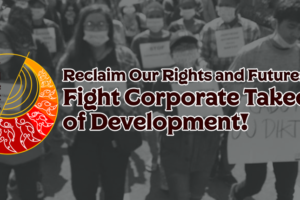The same destructive policy imperatives remain in place
Asia has achieved remarkable economic growth amidst the troubled global economic landscape. It is projected to largely maintain its growth momentum in the next two years, with the region’s GDP expected to pick up to 7.3% in 2013 after it moderated to 6.9% in 2012.[1] Against this backdrop, however, the region remains home to two-thirds of the world’s “multi-dimensionally poor”[2] – half in South Asia (844 million people), and 15% in East Asia and the Pacific (262 million). Some 1.7 billion of its population live on less than $2 a day, and 828 million are struggling on less than $1.25 a day. The actual poverty rates in the region certainly go far beyond conservative estimates.
It is beyond dispute – Asia’s “rapid growth” is leaving hundreds of millions behind, causing a widening gap between rich and poor that threatens to undermine the region’s stability. Income divisions are rising markedly, with the share of income accruing to the richest households increasing over time. The Gini coefficient – a key measure of inequality, where a higher number represents higher inequality – has leapt from 39 to 46 in the last two decades[3], undermining the basis of growth itself.
Fair enough, the Asian Development Bank (ADB), the region’s premier multilateral financial institution, has repeatedly recognized the primacy of arresting this development problem. ADB’s Board of Governors Annual Meeting being held in India this May puts as its core agenda “Development through Empowerment”. ADB explains how widespread poverty and unequal income distribution necessitate public spending and service delivery, which are deemed ineffective without good governance.
While ADB’s pronouncements seem unobjectionable at first glance, the clear disconnect between what it preaches and what it practices raises serious concerns about its objective to pursue development through empowerment. More so, its track record has proven how its policy imperatives have sought to undermine the basic human rights of millions of poor people in the Asia Pacific region.
ADB remains a market fundamentalist in its economic and development strategies. Its approach to poverty reduction and development continues to be hinged on the market fundamentals of rapid economic growth, export-oriented liberalization, financial deregulation, and widespread privatization of public services. All these have severely undermined countries’ sovereignty in determining their own development paths and have restricted people’s and communities’ access to essential services and resources. It has consistently pushed for development policies that have often protected private sector interests at the expense of people’s welfare. It has overhyped the importance of economic growth and enhancing GDP, forgetting that the real purpose of the economy is not to produce GDP but to increase the welfare of the entire citizenry.
This disconnect is manifest, for instance, in public-private partnerships (PPP) implemented by numerous countries in service delivery and infrastructure, often on the grounds that the PPP mechanism allows budget-strapped governments to shift the burden of capital spending to the private sector and contributes to enhanced efficiency in delivering services. However, the experiences of poor communities in the Philippines, Bangladesh, and Indonesia, among others, have proven otherwise. Private sector participation in public services delivery has largely contributed to the exclusion of the poor and has had severe ramifications on issues in equity and access.[4] The usual problems brought about by infrastructure projects under ADB-led PPPs include land encroachment, displacement and resettlement issues. Decision-making structures of these projects are such that they deeply involve bureaucratic agencies and private corporations. As a result, affected sectors and communities are often disempowered since genuine consultation and participation is not practiced.
In such situations where public service becomes privatized and profit-driven, with social costs being pushed to the backseat, the poor are always the most vulnerable. With their lack of paying capacity, combined with the government’s default in ensuring safety nets, the poor end up even more marginalized from access to basic social services that now increasingly “come with a price”.
With a development model that serves the interests of the elite minority, it should come as no surprise why, despite economic growth, Asia has countries with some of the worst unemployment rates; or why 65% of those living in hunger and poverty in the world are in the Asia-Pacific region[5]. All these only further highlight the exclusionary character of the region’s growth.
To appease the growing voices of critics, the ADB has crafted the attractive rhetoric of growth that is “pro-poor” and “inclusive”. For this to materialize, the bank stressed the importance of addressing governance issues leading to the poor performance of public services such as power, water supply, health, education, and nutrition. Despite substantial sums of money spent on public services, the ADB says, the expenditure often does not reach the poor while misallocation of funds and their diversion into private pockets are common.
While corruption is an important concern, to identify it as the overriding problem is to miss the point altogether. Businesses and transnational corporations, having grown in size and power, have subsequently developed strong links with governments to ensure that their interests are prioritized over local peoples. Often, their operations have greatly contributed to massive exploitation of natural resources and frequent abuse of human rights, with government intervention either absent or in support of business lobbyists. The tendency is to frame resulting problems as a mere corruption issue that should be tackled by stopping government officials from taking corporate bribes. What is often sidestepped are the bigger imperatives: that governmental policies uphold the public interest over corporate agenda, and that these corporations remain directly accountable to the people for the impacts of their operations.
ADB’s case shows how, as with most international institutions, the “good governance” catchword is oftentimes being promoted merely as part of a pre-packaged neoliberal call—for governments to practice efficiency and transparency in strengthening private investors’ rights and free market mechanisms through legislation, combating corruption to ensure a “level playing field”, and conducting democratic processes through elections.
While it has identified four components of good governance – accountability, participation, predictability and transparency – all four are set into motion by policy and sectoral reform programs that promote private sector needs over public interest priorities. For example, whether private actors in the economy have procedurally simple and swift recourse for redress of unfair actions or incompetence is seen as the litmus test for accountability. Access to accurate and timely information about the economy and government policies is seen as vital to the private sector’s economic decision-making. Predictability is about developing legal frameworks, especially to support private sector development.[6]
In light of this, the people need to reclaim “good governance” as a concept framed by equitable and sustainable development based on human rights for all, instead of a concept prioritizing the values of private profit. Real good governance strictly observes the democratic principles of equitable participation and inclusion in decision-making. This is the road to genuine empowerment, which on the one hand, the ADB avowedly pursues in ensuring “people the rights and freedom to make decisions in matters that affect their lives, hold others accountable for their promises, or influence development in their communities or even a wider region”[7], but is tragically a far cry from its actual policy prescriptions and conduct of operations.
Experiences on the ground of people and communities show that the ADB’s strategy of "inclusive and pro-poor growth" has not translated into meaningful benefits for the masses and that its deceptive rhetoric is not matched by reality. On the contrary, it has encouraged governments to freeze minimum wages and withhold the rights of workers to association, benefits and protections. It has denied access to water, affordable healthcare, education and transportation services, while its infrastructure projects have led to the displacement of poor and indigenous communities in the Philippines, Indonesia, Nepal, Bangladesh, India, Vietnam and various other countries in the Asia Pacific. These impacts, in turn, have incited growing social unrest in these countries.
In essence, “pro-poor and inclusive” is a mere catchphrase used by the ADB to justify private sector dominance and market expansion in its operations. It should not come as a surprise why inequality, hunger and unemployment continue to soar in a region with robust economic growth; not when ADB’s policy prescriptions tolerate and feed into the myriad of crises at the outset. ###
_______________________________________________________________________________________________
NOTES:
[1] Asian Development Outlook 2012: Confronting Rising Inequality in Asia (Manila: ADB, 2012) Retrieved from: http://www.adb.org/sites/default/files/ado2012-highlights.pdf
[2] Multidimensional Poverty Index (MPI) reflects the deprivations that a poor person faces all at once with respect to education, health and living standard. Unlike the Human Development Index which is based on country averages of these same dimensions of deprivation, the MPI is based on the number of people at the household level who face these deprivations simultaneously. Human Development Report 2010 —20th Anniversary Edition. The Real Wealth of Nations: Pathways to Human Development. (New York: United Nations, 2010).
[3] Asia’s Increasing Rich-Poor Divide Undermining Growth, Stability (ADB Report, 2012) Retrieved from: http://www.adb.org/news/asias-increasing-rich-poor-divide-undermining-growth-stability-adb-report
[4] Amrita Datta, “Public-Private Partnerships in India: A Case for Reform?” Economic and Political Weekly 44:33 (2009)
[5] The Asia-Pacific region is home to 578 million of the world’s 925 million people who are malnourished, representing almost no change in the absolute number of hungry people in 20 years despite rapid economic growth in most countries. Of that total, 91 percent live in just six countries: India, China, Pakistan, Bangladesh, Indonesia and the Philippines. (FAO: Hunger becoming more complex in Asia and the Pacific, http://www.fao.org/asiapacific/rap/home/news/detail/en/?news_uid=128590)
[6] A Master-plan for Market Expansion: The Asian Development Bank and Governance, http://focusweb.org/node/259
[7] Development through Empowerment: Delivering Effective Public Services, Asian Development Bank, http://www.adb.org/sites/default/files/projdocs/2012/46195-001-reg-tar.pdf


